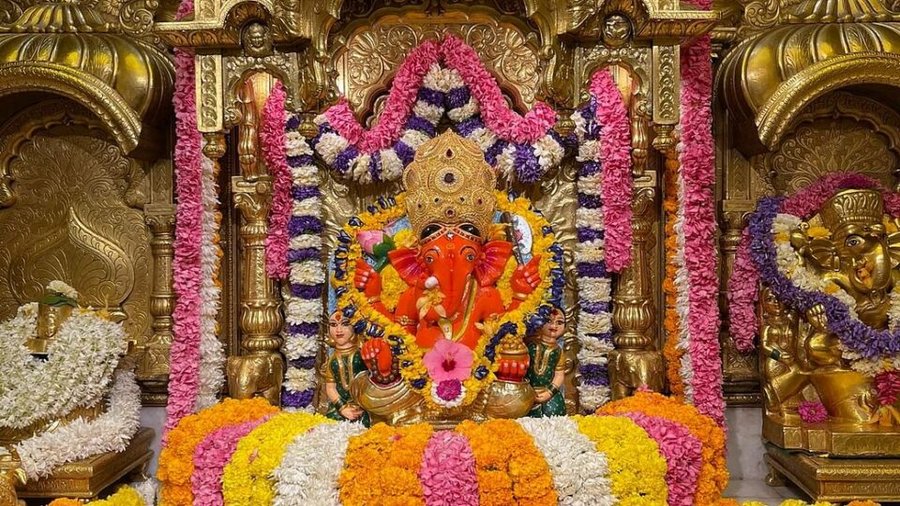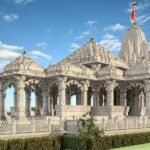Lord Ganesh, the Vighnaharta, and the Mangalmurti are going to arrive once again at our houses to fill the atmosphere with positivity, happiness, and prosperity as Ganesh Chaturthi is approaching. A religious ritual or Pooja is incomplete without invoking Lord Ganesh and offering him our prayers. Lord Ganesh is always the first one to be worshipped be it any new beginning in life, a new job, a new car, a new home, and Ganesha has to bless it first for us to be content. Lord Ganesha is one of the most worshipped lords in Hindu Mythology and a total of 8 temples known as Ashtvianyak or 8 temples dedicated to Lord Ganesha are revered by the devotees who visit these temples often in their life to seek blessings directly from Lord Ganesha. These Ashtvinayak temples are:
Mayureshwar Mandir
This temple is one of the 8 Ashtvinayak temples situated in Morgaon in Pune, Maharashtra. It is also known as one of the Swayambhu forms of Lord Ganesha. According to the Ganesh Purana, Mayureshwar, also known as Moreshwar, was the form Lord Ganesha took in Treta Yuga. Legend has it that there was a demon named Sindhu who was an ardent devotee of Surya Devta or the Sun god. Sindhu had attained great powers from the sun god as a boon for his devotion. The Sun god granted him the boon of ruling the three worlds and a bowl of amrita or elixir that never exhausted.
Sindhu started tormenting all the gods because of his boon and the gods were compelled to pray to Lord Ganesha. Lord Ganesha came down to earth in the form of Mayureshwar or the Lord of Peacock to annihilate this demon. He broke his bowl by cutting open his stomach as Sindhu had swallowed it and thus, the terror of the demon came to an end. Lord Ganesha gave his vehicle Peacock to his younger brother Muruga later on which is generally associated with a peacock as his vehicle.
Siddhivinayak Temple
Siddhivinayak temple is Prabhadevi, Mumbai is one of the most popular and the most visited of the Ashtvinayak temples. The construction of this temple dates back to 1801 when it was built by a common man Laxman Vithu and funded by a rich but childless woman Deubai Patil. This temple made out of Marble and pink granite was originally a small temple with 3.6 meters*3.6 meters square feet made of brick but was later renovated and rebuilt in the grand manner that we see today in 1990.
This temple was funded by Deubai Patil with the belief that Lord Ganesha will grant the wishes of women who have not had a child yet. The original idol made of black stone is still kept intact inside the temple. According to the local legends, Ramakrishna Jambhekar Maharaj, an ardent devotee of Saint Akkalkot Swami Samarth, buried two idols in front of the temple and a tree grew at the spot with an imprint of Swayambhu Ganesha on its branches.
This temple is extremely popular during the festival of Ganesh Chaturthi and people generously visit and pray to the Chaturbhuj idol which has is consorts Ridhi and Sidhi on either side. The temple is also flooded with tourists and devotees on Tuesdays because this is considered to be an auspicious day to worship Lord Ganesha.
Ballaleshwar temple
Ballaleshwar temple is located in Pali village at a distance of 30 km from Karjat in the Raigad district. The temple is situated between the river Amba and Fort Sarasgad and is famous for responding quickly to the devotees’ prayers. Lord Ganesha manifested himself here to bless his ardent devotee and in turn remained in the village with the name of his devotee as Ballaleshwar.
The legend behind this temple goes on that there was a merchant named Kalyani Seth who had a son named Balllala. He used to performed Ganesha Puja regularly and invite all the children of the village to his daily evening Pooja. The children used to get immersed in the Pooja completely and this meant they reached home quite late at night. All the parents complained about this to Kalyani and Kalyani got so angry that he threw the idol of Ganesha in the forest and beat Ballala mercilessly. Kalyani then tied Ballala up but despite the injuries and being tied up Ballala continued his prayers to Ganesha.
Impressed by his devotion, Ganesha appeared in front of Ballala and healed all of his wounds. Ballala then asked Ganesha to never leave the village and stay with him as Ballaleshwar to which Ganesha agreed. The idol which Kalyani Seth threw into the forest is still worshipped as Dhundi Vinayak.
Varadvinayak temple
Varadvinayak temple is situated in Mahad samil town in the Khalapur Taluka near Karjat in the Raigad district of Maharashtra and is one among the most famous Ashtvinayak temples. The idol at Varadvianyak is also Swayambhu and the name of Ganesha here means the giver of abundance and success. This temple is also recognized as a Matha. This ashtavinayak shrine faces east and is known as Purvabhimukh.
According to the legends, a prince named Rukmagada went hunting into the forest where Sage Vachaknavi and his wife Mukundaa lived. When Mukunda saw the prince, she felt attracted to him and expressed his desire for him but Rukmagada rejected her proposal. Mukundaa cursed him that he would lose his beauty and turn into a leper. On the other hand, Indra got to know about Mukundaa‘s desire and disguised himself as Rukmagada to fulfill her desire. Mukundaa then gave birth to a son named Gritsamav.
Gritsamav grew up to become a great scholar and once went to a debate where the most renowned Rishis were invited. A famous sage Atri objected to his presence and denied having a debate with him saying that he was not a true Brahmin. Dejected Gritsamav demanded to hear the truth from his mother and after hearing the truth he got so angry that he cursed his mother to turn into a thorny Ber Tree. His mother in turn cursed him to bear the pain of being a parent to a heartless and cruel child since he had been so harsh on his mother. To relieve him of the curse he performed severe penance and Ganesha appeared and granted his wish to be recognized as a Brahmin. He also requested Ganesha to reside in the Pushpak forest where he performed penance and Lord Ganesha manifested as Varadvinayak here.
Chintamani Temple
Chintamani temple another important temple is the series of Ashtvinayak temples is situated in north-western Sehore in Madhya Pradesh. This temple is considered to be established around 2000 years ago by Vikramaditya. The folklore connected to this temple is that the King of Ujjaini, present-day Avantika, used to worship Chintamani Ganesha religiously and one day Lord Ganesha blessed him with a message by appearing in his dream and said that Lord Ganesha would appear in the form of a lotus in one of the rivers in the west of the temple.
Lord Ganesha then went on to instruct the king in his dream to collect the flower and take it to any desired location he wanted. Ganesha said that the lotus flower would convert into an idol of Ganesha and get established wherever it remains when the sun rises. The King did as instructed but while bringing the lotus back to the temple, his chariot got stuck in the mud. Even after making many efforts, the chariot did not move and when the sun rose the flower got converted into an idol half immersed in the mud. The idol did not even move from the place so the King had to build a temple there itself.
Girjatmaj temple
Girjatmaj temple is the only one of the Ashtvinayak temples to be situated on a mountain. This temple is also known as Lenaydri Ganpati temple as it is mentioned in the Ganesh Purana. This is a cave temple situated between several Buddhist caves in the region. According to the Ganesh Purana, Goddess Parvati who is also known as Girija performed penance on the Mountain to beget Lord Ganpati as her son. He once made an idol out of the dirt that she wiped out from her body and this happened to be the fourth day of Bhadrapad Shuddha.
This young incarnation of Vighna Harta Ganpati is said to have lived among the mountains for nearly 15 years. This cave temple is completely devoid of any other source of light except sunlight and is constructed in a manner that the entire temple gets illuminated when the sun rises and till the time the sunsets. It takes 307 to 315 steps to reach this cave temple. The deity of Lord Ganesha here is a monolithic idol unsupported by any pillar. The view outside the temple with the Kukadi River flowing nearby has a very calming effect on the minds of devotees.
Vighnaharta temple
The Vignahar temple situated in Ozar or Ojhar near Pune, Maharashtra is a unique temple and completely different from the other Ashtvinayak temples. This temple is unique because it is the only one of the Asta Vinayak temples to have a golden dome known as Sonayacha Kalash and a pinnacle. This temple celebrates the Vigneshwara form of Lord Ganesha or the Lord of Obstacles or Vighnahara or the remover of the obstacles.
This temple is associated with the legend that Lord Ganesha annihilated Demon Vignausra who had wreaked havoc on earth. He is accompanied by his consorts Riddhi and Siddhi on either side. This temple is also famous for its Deepmala or beautiful lightings. Vignahara temple is especially adorable during the time of Ganesha festivals like Ganesh Jayanti and Ganesh Chaturthi. Vignahara temple is also looked upon as the epitome of Vasushastra or architectural science.
Mahaganpati temple
Mahaganpati temple is the last ashtvinayak temple visited by devotees of all the eight temples. The Mahaganpati form also known as Mahotkat form is depicted in a very aggressive manner with 10 trunks and 20 hands. The Idol of Lord Ganesh is seated on a temple and is flanked by his two consorts Riddhi and Siddhi. This temple is situated in Ranjangaon near the Pune-Ahmednagar highway.
Ganesh Purana says that there was a sage named Gritsamad whose sneeze gave birth to a boy. The sage pampered the boy as his own and taught him the Ganana Twam or the Ganesh Mantra. The boy meditated intensely chanting the same Mantra and impressed Lord Ganesh. Lord Ganesh granted him a boon of three Puras of Gold, silver, and iron and thus the boy came to be known as Tripur. Lord Ganesh also granted him the boon of him the most powerful whom only Lord shiva could defeat.
Tripur grew proud and arrogant after receiving the boon and brought terror to the world. He captured the earth and moved up to heaven to defeat Indra. He captured heaven and because of his terrifying anger, Lord Brahma hid in a Lotus and Lord Vishnu in Shirsagar. He later went on the capture Kailash too and thus became the ruler of the three worlds. All the Gods prayed to Lord Ganesh for help and Ganesh answered their prayers.
Ganesh went in disguise to Tripurasur and said that he would make him three planes with which he could travel anywhere but Tripurasur had to give Chintamani idol in return. When Tripurasur sent his messenger to bring the idol, Lord Shiva refused to give it to him and this angered Tripurasur. Tripurasur himself went to get the idol and a war waged between Shiva and Tripurasur in which Tripurasur destroyed everything on Kailash and Lord Shiva also retired to Girikandar.
Lord Shiva realized that he had not paid respect to Lord Ganesh and on doing so, Ganesh advised him to chant the Shastranam while pointing arrows at the three Puras of Tripurasur and that destroyed the demon. Lord Shiva built a temple where he summoned Lord Ganesh and that place came to be known as Manipur while the place where Lord Shiva sought the blessings of Lord Ganesh was Ranjangaon.
Thus, as the festive season is approaching it is going to be a very exciting and spiritual journey. So make sure to visit the Ashtvinayak temples and seek blessings from Ganpati Bappa to be relieved of all worries and welcome prosperity and spirituality in your life.




